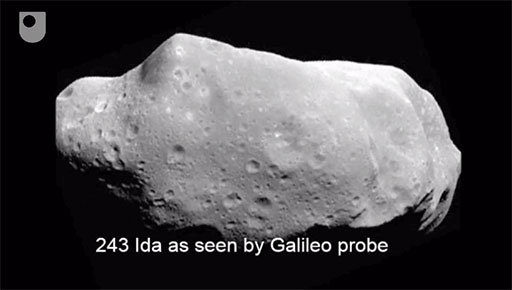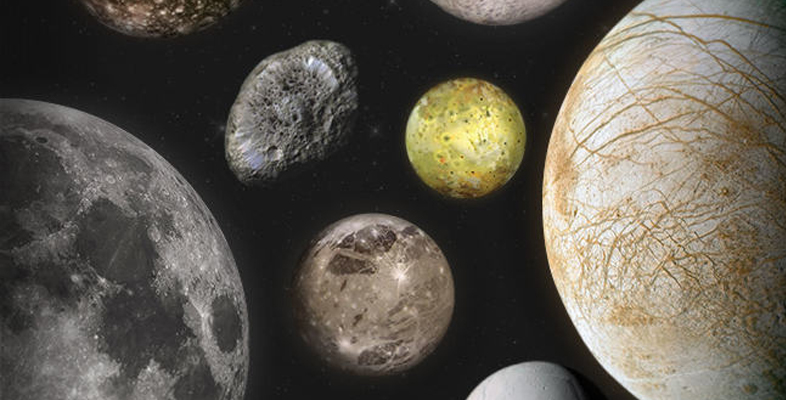3.3 The moons of asteroids
Find out about some moons of asteroids seen by spacecraft that have flown past or crashed into, or have been seen by optical telescopes or imaged by radar when they pass very close to the Earth.
In March 2014 a particularly surprising discovery was announced concerning moons of asteroids. Seven southern hemisphere telescopes monitored a predicted occultation (hiding) of a star by the asteroid 10199 Chariklo, which is a 250 km diameter icy asteroid orbiting beyond Saturn (it belongs to a class of bodies known as Centaurs). The observations of this rare event were intended to refine our knowledge of Chariklo’s size and shape (which they did). However, the light from the star dimmed twice very briefly a few seconds before the main occultation, and did so again a few seconds after. This shows that Chariklo has two rings (perhaps formed of debris resulting from a collision), 7 km and 3 km wide and separated by a 9 km gap. This is the first known ring system round anything other than a giant planet. Moreover, the only known way to confine the ring system so tightly is if Chariklo also has at least one shepherd moon, analogous to Saturn’s Pan and Prometheus. Read more and see an artist’s impression of Chariklo and its rings [Tip: hold Ctrl and click a link to open it in a new tab. (Hide tip)] .

Transcript
Another moon of a near-Earth asteroid, even smaller than the moon of 1998 QE2 that you saw in the video, was discovered using radar on 26 January 2015 when the 325 m asteroid 2004 BL86 passed at a distance of only 1.2 million km. Its moon is about 70 m in size making it the new record holder for the smallest known moon.
On 1 September 2017 during a close approach to Earth by the 4.5km asteroid Florence, two 100-300m moons were discovered orbiting it.
In 2022, astronomers announced the discovery of a third moon of the 200 km asteroid (130) Elektra, the first known example of an asteroid with more than two moons. The newly found moon is the innermost of the three, and is less than about 2 km across.
On 26 September 2022, NASA’s DART (Dual Asteroid Redirection Test) mission deliberately crashed into the 160m diameter Dimorphos, which is the moon of 780m diameter asteroid Didymos. The impact shortened the moon’s orbital period from 11h 55m to 11h 23m as a way of testing whether such impacts could be an effective way of changing the trajectory of an asteroid that was on a collision course with the Earth.
In November 2023, NASA’s Lucy mission flew past 790m asteroid Dinikesh and discovered that it has a 220 m moon that may be a ‘contact binary’, as you saw in Week 1.
What about comets, could a comet have a moon? None has ever been found, however some comet nuclei are ‘contact binaries’ made of two lumps in contact. The comet famously visited by ESA’s Rosetta Probe in 2014-16 is one of these. There is a short bonus video at the link given below, in which David Rothery discusses the issue with a member of the Rosetta camera team.
See also:
- A moon of a comet? A quick look at whether the two-lobed nucleus of a comet could have originated as a main body plus a moon (duration 2m 15s).
- A mission to ‘Didymoon’ Information (and a lovely video) about ESA’s proposed 2023 mission to the moon of asteroid Didymos.
